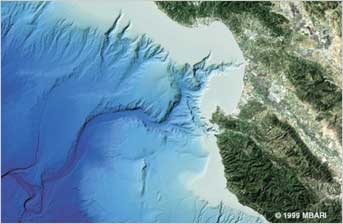The Monterey Bay has many different habitats in different depths of water. Some animals and plants in the intertidal zone live in tide pools. Tide pools are small puddles or pools of seawater, which are left behind during low tide. These habitats can contain only an inch or two of water. Many pelagic animals swim freely in water of any depth, while other animals live in the deep dark water of the Monterey Canyon.
Deep water is a very special environment that contains fascinating and sometimes spooky forms of life. Deep-water environments like the Monterey Canyon contain lots of zooplankton, which provide food for many animals in the food chain. Animals that live in deep water have to adapt to the pressure of all the water above them. Many deep-water animals live in total darkness and have adapted to the dark and the pressure in strange and bizarre ways.
The anglerfish attracts its prey with a lure that glows in the dark. The vampire squid had adapted to the darkness in the Monterey Canyon by having very large, sensitive eyes.

Questions:
No, because phytoplankton needs light for photosynthesis.
The deepest dive with out equipment ever recorded is 417 feet. The deepest dive with scuba equipment was a little deeper at 475 feet.
The Marianas Trench is 35,838 feet deep or about seven miles.
